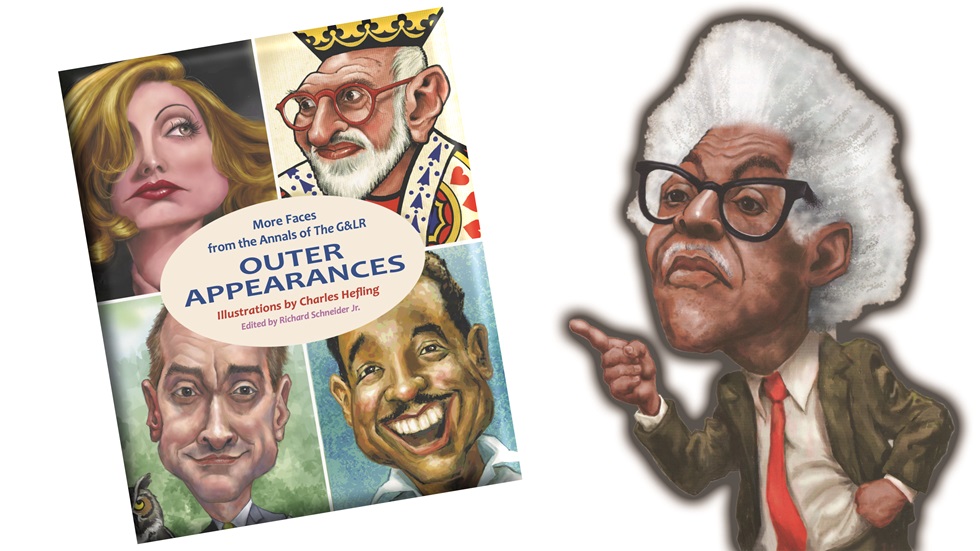
It’s only 64 pages long, but it’s fully loaded with portraits of famous queer, mostly American, performers, playwrights, writers, artists and activists who have made a difference in the world. On facing pages of this 9 x 7.5” paperbound book we encounter 27 short bios (ca. 400 words) by many different authors on the verso, and Charles Hefling’s charming portraits on the recto side.
The texts are largely drawn from past issues of The G&LR, which began life in 1994 as The Harvard Gay Lesbian Review, a queer magazine mostly focusing on ideas, books, literature, the arts, science, and evolving trends in the queer world. This book celebrates the magazine’s 30th anniversary.

Outer Appearances is a sequel to an earlier book featuring Hefling’s art, Casual Outings, which focused more on figures from our historical past who were less “out” in a modern sense than queer people are now. Those figures included the likes of Michelangelo, Franz Schubert, Franz Kafka, Grant Wood, Federico García Lorca, John Cheever, Langston Hughes and Lorraine Hansberry. Of the 27 in the present volume, who are generally speaking “outer” than the first book’s subjects, nine (by my count) are still living. Curiously, a second essay on Hughes appears in the second volume—a writer the queer world certainly is proud to claim.
Those who “Don’t Say Gay” in the classroom, the public library or in general discourse, seeking to dissuade young people from perceiving queer individuals as potential role models, will have a lot of ’splainin’ to do to account for the innumerable contributions LGBTQ+ people have made.
In its five categories, the new release features Cary Grant, Greta Garbo, Little Richard, Harvey Fierstein, Melissa Etheridge, Alan Cumming, and James Whiteside as performers. Jean Genet, Stephen Sondheim, Mart Crowley, Terrence McNally and Charles Ludlum as playwrights. Gertrude Stein, Langston Hughes, Patricia Highsmith, Gore Vidal, Susan Sontag, and David Sedaris as writers, including a page on The Violet Quill, a gay writers’ affinity group whose survivors include Felice Picano, Edmund White, and Andrew Holleran. The artists include Tom of Finland, Edward Gorey, Keith Haring, and Alison Bechdel. And the activists are Eleanor Roosevelt, Pauli Murray, Bayard Rustin, and Larry Kramer. Eight subjects are women.

Thumbnail pen portraits of a creative person’s career rarely come out as memorable writing, but there are some exceptions in Outer Appearances. Allen Ellenzweig’s essay on playwright Mart Crowley (1935-2020) opens like this:
It was either kismet or dumb luck that the original production of The Boys in the Band appeared Off-Broadway in 1968, the year before the Stonewall Riots. Everyone of note seemed to be pulling up in his or her limo to watch a group of Manhattanite gay men throw a birthday party for one of their own. People were drawn to the fast-paced repartee, the transgressive language, and the certainty that one was in for a slice of tribal anthropology, only a hell of a lot funnier. Straight people went to it no doubt hoping to learn the secret of why those gay boys were so damn entertaining.
Even in purely expository writing, many of the authors are able to use their few words to summarize a whole era of history and place their subject firmly and essentially within it. Here is Martha Miller, for example, on Pauli Murray:

In 1963, Murray became one of the first people to criticize the sexism in the civil rights movement. She recognized that discrimination based on race and gender were closely related, and African-American women carried a double burden. She coined the term “Jane Crow” to characterize the status of women in general and Black women in particular. Murray worked with both women’s groups and civil rights organizations, advancing the use of the Fourteenth Amendment, the Equal Protection Clause, and litigation in general to end both racial and gender discrimination. Among her legal victories was White v. Crook, which she argued (with Dorothy Kenyon) before the U.S. Court of Appeals for the Fifth Circuit, receiving a decision that guaranteed women the right to serve on juries. While not as well-known as some other feminists and civil rights leaders, Pauli Murray was an actor in two of the great social movements of the last century.

Clearly, far more background detail on all of these individuals can instantly be found on the Internet. The true joy is in Hefling’s art, a lasting joy to be savored again and again. The artist has had quite a varied career himself. Here’s his bio:
Charles Hefling began to draw funny pictures at the age of four, inspired by Walt Disney. As an undergraduate, he was a regular contributor to Harvard Magazine, and the University archives has a collection of his posters for concerts and other events. He has illustrated several books, among them Have a Word on Me, by Willard Espy. He is now a retired professor, having taught theology, philosophy, and Great Books at Boston College for thirty years. Besides drawing and (digital) painting, his artistic pursuits include calligraphy and manuscript illumination.
Outer Appearances: More Faces from the Annals of The G&LR
Illustrations by Charles Hefling
Ed. by Richard Schneider Jr.
Boston: G&LR Books, 2024
ISBN: 979-8-9888150-2-0
$14.95
We hope you appreciated this article. At People’s World, we believe news and information should be free and accessible to all, but we need your help. Our journalism is free of corporate influence and paywalls because we are totally reader-supported. Only you, our readers and supporters, make this possible. If you enjoy reading People’s World and the stories we bring you, please support our work by donating or becoming a monthly sustainer today. Thank you!












Comments